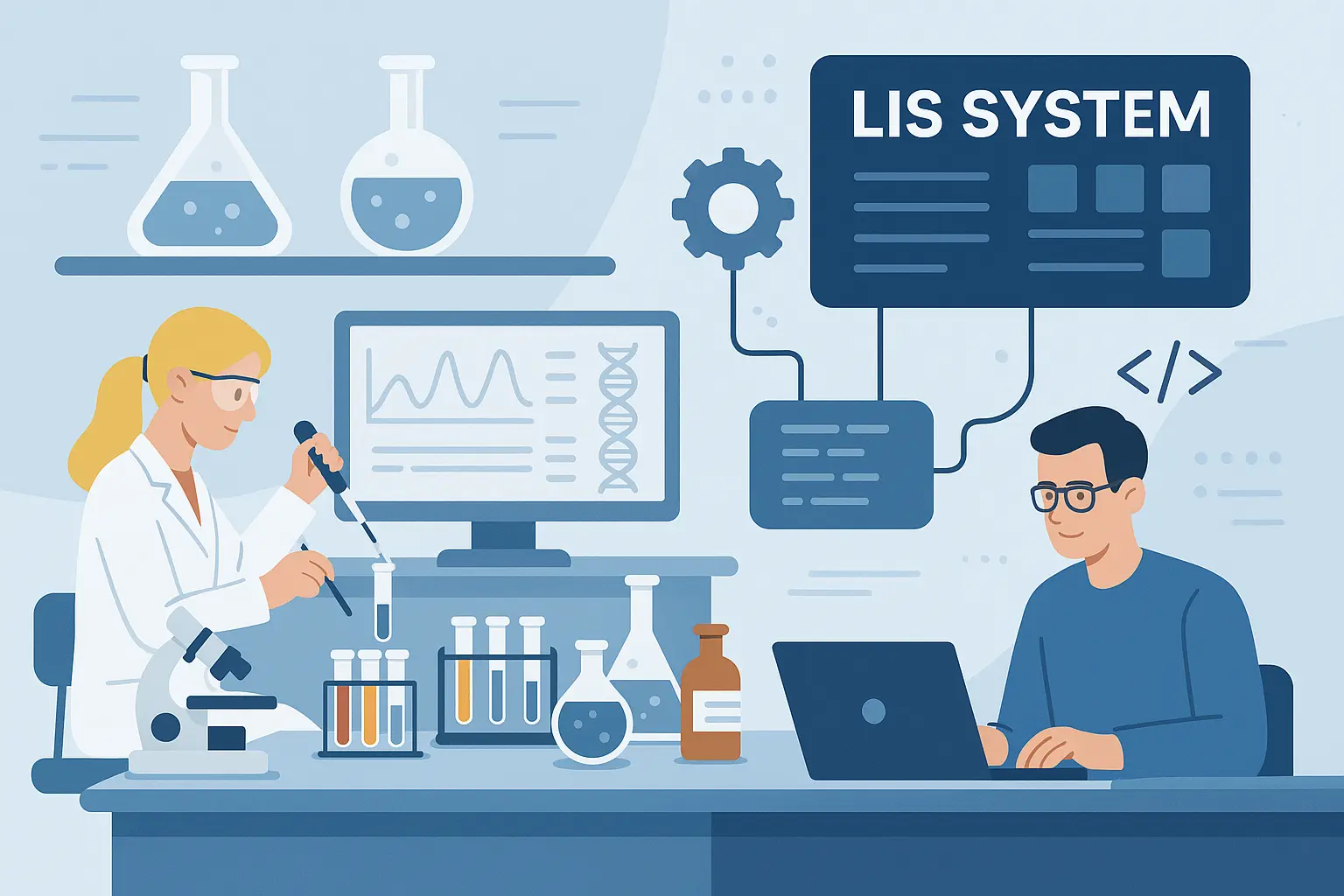Blog
Differences Between Laboratory Information Management Systems (Lab LIMS) and Laboratory Information Systems (LIS Systems)
January 24, 2025
Clinical labs and pathology practices handle vast amounts of specimen data for processing. Patient health records include diverse information related to medical history, blood work, image scans, lab reports, and prescriptions, all of which need to be systematically recorded to support clinical lab workflow and securely manage patient data and sample tracking. If a medical laboratory is to draw evidence-based clinical insights from these data sets, the information needs to be organized and accessible within a proper pathology lab management system.
Laboratory information systems (LIS system software) and laboratory information management systems (lab LIMS) are two types of pathology lab reporting software solutions that help manage and organize this data.
Laboratory information system software is usually deployed within a clinical setting (for instance an anatomic pathology LIS in an independent laboratory or a medical LIS or healthcare LIS in a hospital) to manage patient-centric data.
On the other hand laboratory information management system software is generally sample-centric. It is designed for analytical laboratory settings such as food manufacturing, pharmaceutical, and non-clinical testing environments.
A note before we dive deeper. While laboratory information systems and laboratory information management systems are lab terms that have different technical meanings, these terms are often used interchangeably in the laboratory world. In this article, we will treat them as distinctly separate laboratory management solutions based on their original definitions even though not everyone draws these distinctions.
LIS vs LIMS: Comparing and Contrasting Both Laboratory Software Systems
For any lab (medical or otherwise) to process more than 100 cases per day either a laboratory information system or laboratory information management system is necessary. These laboratory software systems from LIS software vendors/LIMS vendors enable mid-to-large-scale laboratories to leverage diagnostic lab software technology to run efficiently and scale their operations.
Put simply, a robust medical LIS and LIMS lab management system each has the power to unlock bottlenecks and barriers that otherwise would keep an organization from growing.
When comparing a lab information system versus a laboratory information management system, one must remember they are two distinct diagnostic lab software. Both improve Standard Operating Procedures (SOPs) by structuring data collection, testing, diagnosis, and treatment and both reduce the time spent recovering data and decrease transcription errors.
While both LIS systems and lab LIMS represent laboratory workflow management solutions for streamlining lab data, they differ in their purpose, based on a particular lab’s needs.
Laboratory information system functions focus on medical laboratory solutions for patient information and test results, while lab information management system functions focus on test samples. For example, a patient’s medical history, demographics, test results, disease diagnosis, and treatment are generally processed with a laboratory information system LIS software.

What is a LIS Laboratory Information System?
A LIS laboratory information system focuses on collecting, processing, storing, and managing patient information and results from their clinical examination. It is a clinical laboratory workflow management solution that manages patient and sample data. Doctors and lab technicians use these LIS systems to synchronize and manage various patient medical tests.
There is an overlap between the functionalities of LIS system software and lab LIMS software, which pivots on the interface between the bench and clinical setting. LIS systems maintain patient information in a database that enables quick retrieval of data and an analysis of reported test results with their diagnoses and treatment.
Laboratory Information System (LIS) Benefits
Examples of laboratory information systems that streamline processes related to patient data include areas of data sharing and cross-referencing. For instance, a lab information system enables secure data sharing with public healthcare enterprises, to inform clinical decisions.
When incorporated with a hospital’s electronic health record (EHR) system the laboratory information system software manages patient sample tracking while correctly cross-referencing a patient with his or her lab test results.
Basic LIS lab software solutions eliminate errors in the interchange between a clinical setting and the lab by serving as an effective lab interface system with automated annotation of data points. If a doctor orders blood work for a patient, for example, they use a code to indicate which tests are to be processed. The laboratory information system then matches this code with the lab’s specimen to ensure the test is performed correctly for that particular sample.
Also noteworthy is that the best LIS laboratory information system software includes innovative laboratory billing solutions (billing software for labs) embedded within the LIS system software to create an all-in-one informatics solution that covers a medical lab’s technical and financial operations.
LIS Systems and Laboratory Information System Companies
Modern laboratory information systems streamline and automate processes, creating leaner, more accurate, scalable, and more efficient operations while providing complete visibility into core business processes.
The best LIS systems and the best laboratory information system companies can manage all departments and operations (including financial operations) with no data silos and no synchronization of master files (clients, tests, physicians, insurance, pricing, etc).
These advanced lab pathology software solutions also eliminate human errors and lost specimens with error-free sample tracking, maximize efficiency and connectivity with engines that support rules, automation, and interoperability, improve turnaround times with intuitive designs that minimize the need for clicks and support macros, enable the creation of customizable lab reports and the delivery of these reports in multiple ways to cater to client preferences, support remote access for orders and results retrieval, provide valuable real-time business analytics, and minimize risk with compliance verification at every stage.
Learn More: How LigoLab's Pathology Lab Software Supports Lab Report Customization and Client Preferences
To learn more about laboratory information functions that make LIS systems modern game-changers for medical labs, contact LigoLab and request your personalized LIS software demo.

What is a Laboratory Information Management System (Lab LIMS)?
Laboratory information management system software (lab LIMS) allows non-medical testing facilities to manage high-volume samples and associated data points. This enables a lab to automate workflow (such as sample tracking) and produce reliable results.
A laboratory information management system does just as its name states, managing vast amounts of data at various stages of lab operations (such as sample management, workflow management, inventory management, etc.) with these functions serving to streamline laboratory operations, improve data integrity, enhance productivity, and ensure compliance with regulatory standards.
A laboratory information management system (LIMS lab management software) is widely used in various regulated industries because it supports laboratory workflow management while adhering to set regulations.
Examples of LIMS systems include the following:
- An environmental lab using a laboratory information management system to monitor water quality, analyze air and soil samples, and ensure compliance with environmental regulations imposed by government agencies.
- A food and beverage laboratory using LIMS lab management software to manage food safety testing, track ingredients, and ensure compliance with food safety standards.
- A chemical laboratory using a lab LIMS to manage chemical inventory, track hazardous materials, and ensure compliance with safety regulations.
Benefits of Laboratory Information Management Systems
The best LIMS lab information management systems help non-medical laboratories with quality assurance and control. Besides individual sample tracking management, they also enable batch tracking.
Industries like food and pharmaceutical manufacturing must maintain certain quality standards prescribed under the Good Manufacturing Practice (GMP) and lab information management systems ensure that the labs can stick to the standards set by the GMP code.
With the help of LIMS lab management software, laboratories can handle complex data systems without any scope for errors. The best LIMS can also be integrated with other laboratory software systems to enhance data handling and reporting even more.
With the rapid advancement of technology, laboratory information management systems have adapted to improve lab performance by automating lab workflow, integrating analytical instruments, and standardizing data outputs. Modern laboratory information management systems enable lab staff to track data over time and provide retrospective solutions that improve workflow efficiencies.
Data management is an increasingly central component in labs due to the high volume of data generated in these environments. Without innovative and automated solutions for sample tracking and lab workflow, tests could be backlogged over long periods, potentially delaying the whole process.
Additional advantages of lab information management system software from innovative LIMS vendors include tracking reagents and promptly procuring resources.
Once processes are implemented within the LIMS lab management software the generated data can be used to restructure SOPs if required. This data is useful for bench workers and lab staff, who can use it to find faster solutions, redesign experimental setups, innovate lab workflow, and reuse components of the lab LIMS that demonstrate efficient performance.
Learn More: Laboratory Information Systems (LIS vs LIMS) for Data Management

Challenges Confronting LIMS Lab Management Software
In some cases, lab information management systems can be considered difficult to install and maintain. Also, no matter the LIMS or the LIMS vendors, personnel must be trained to use and leverage the LIMS lab management software to improve laboratory workflow management.
Even with a basic laboratory information management system, employees not acquainted with the LIMS software may build illogical workflows that prolong the time spent during processing.
Buying a Laboratory Information Management System from LIMS Vendors
LIMS vendors sell lab LIMS that can structure large volumes of data and then streamline it for customer use and understanding. Numerous LIMS vendors offer services that enable seamless sample tracking throughout its processing workflow. This facet is the most important metric for the performance of a laboratory information management system.
LIS vs LIMS: Laboratory Workflow Management Conclusions
In the debate over LIS vs LIMS, one thing is certain. LIS systems and LIMS lab management software solutions are crucial tools to support laboratory workflow management.
These laboratory software systems overlap in some functionalities but differ in their applications.
The LIS system is a cross-referencing, data retrieval, recording, and data storage medical lab application that can be integrated with an EHR and other third-party solutions (for example lab billing with laboratory revenue cycle management software) to accelerate clinical insights and technical and financial operations.
The laboratory information management system, on the other hand, is a functional tool that in most cases manages industrial specimen samples, tests, results, and tracking.
These laboratory software systems thus power the machinery of data collection, management, and analysis. By implementing the best LIS or LIMS software for their specific needs, laboratories can improve their accuracy and efficiency and service a broad spectrum of clients while handling large numbers of samples and complex data sets, no matter the type of testing.






